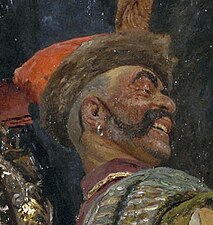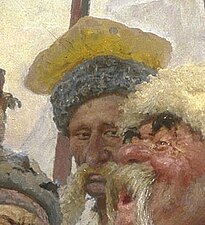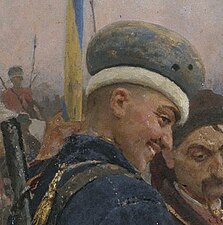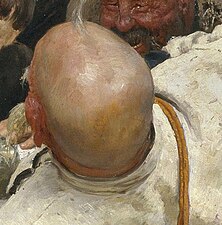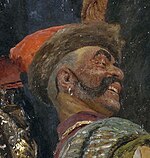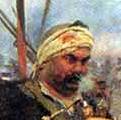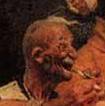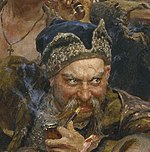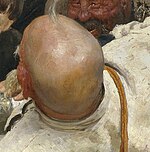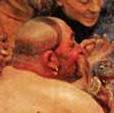
Ilya Yefimovich Repin was a Ukrainian-born Russian painter. He became one of the most renowned artists in Russia in the 19th century. His major works include Barge Haulers on the Volga (1873), Religious Procession in Kursk Province (1880–1883), Ivan the Terrible and His Son Ivan (1885); and Reply of the Zaporozhian Cossacks (1880–1891). He is also known for the revealing portraits he made of the leading Russian literary and artistic figures of his time, including Mikhail Glinka, Modest Mussorgsky, Pavel Tretyakov, and especially Leo Tolstoy, with whom he had a long friendship.

The Zaporozhian Cossacks, Zaporozhian Cossack Army, Zaporozhian Host, or simply Zaporozhians were Cossacks who lived beyond the Dnieper Rapids. Along with Registered Cossacks and Sloboda Cossacks, Zaporozhian Cossacks played an important role in the history of Ukraine and the ethnogenesis of Ukrainians.
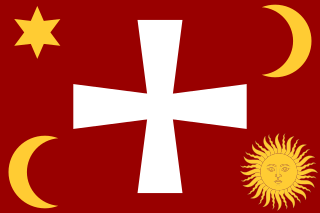
The Zaporozhian Sich was a semi-autonomous polity and proto-state of Cossacks that existed between the 16th to 18th centuries, including as an autonomous stratocratic state within the Cossack Hetmanate for over a hundred years, centred around the region now home to the Kakhovka Reservoir and spanning the lower Dnieper river in Ukraine. In different periods the area came under the sovereignty of the Polish–Lithuanian Commonwealth, the Ottoman Empire, the Tsardom of Russia, and the Russian Empire.

Zaporizhzhia or Zaporozhzhia is a historical region in central east Ukraine below the Dnieper River rapids, hence the name, literally "(territory) beyond the rapids".

Black Sea Cossack Host, also known as Chernomoriya, was a Cossack host of the Russian Empire created in 1787 in southern Ukraine from former Zaporozhian Cossacks. In the 1790s, the host was re-settled to the Kuban River. It comprised the Caucasus Fortified Defence Line from the mouth of the Kuban River to the mouth of the Bolshaya Laba River.
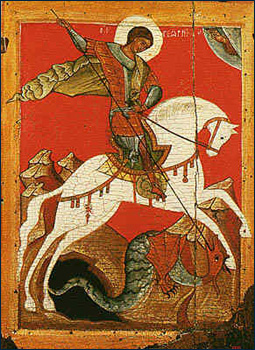
Among the collections of the Russian Museum in Saint Petersburg in Russia are some of the greatest pieces of Russian art in the world.

Taras Bulba is a romanticized historical novella set in the first half of the 17th century, written by Nikolai Gogol (1809–1852). It features elderly Zaporozhian Cossack Taras Bulba and his sons Andriy and Ostap. The sons study at the Kiev Academy and then return home, whereupon the three men set out on a journey to the Zaporizhian Sich where they join other Cossacks and go to war against Poland.
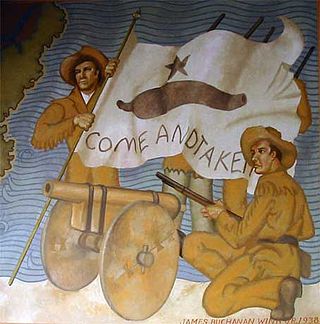
"Come and take it" an expression of defiance first used in 1778 at Fort Morris during the American Revolution, and also in 1835 at the Battle of Gonzales during the Texas Revolution.

Dmytro Ivanovych Yavornytsky was a Ukrainian academician, historian, archeologist, ethnographer, folklorist, and lexicographer.

Fyodor Ignatievich Stravinsky, 20 June [O.S. 8 June] 1843, estate Novy Dvor (Aleksichi), Rechitsky Uyezd, Minsk Governorate – 4 December [O.S. 21 November] 1902) was a Russian bass opera singer and actor. He was the father of Igor Stravinsky and the grandfather of Théodore Strawinsky and Soulima Stravinsky.
Khortytsia is the largest island on the Dnieper River, and is 12.5 km (7.77 mi) long and up to 2.5 km (1.55 mi) wide. The island forms part of the Khortytsia National Reserve. This historic site is located within the city limits of Zaporizhzhia, Ukraine.

Yurii Khmelnytsky, younger son of the famous Ukrainian Hetman Bohdan Khmelnytsky and brother of Tymofiy Khmelnytsky, was a Zaporozhian Cossack political and military leader. Although he spent half of his adult life as a monk and archimandrite, he also was Hetman of Ukraine on several occasions — in 1659-1660 and 1678–1681 and starost of Hadiach, becoming one of the most well-known Ukrainian politicians of the "Ruin" period for the Cossack Hetmanate.
Ivan Sirko was a Ukrainian Cossack military leader, Koshovyi Otaman of the Zaporozhian Host and putative co-author of the famous semi-legendary Cossack letter to the Ottoman sultan that inspired the major painting Reply of the Zaporozhian Cossacks by the 19th-century artist Ilya Repin.

Vladimir Alekseyevich Gilyarovsky, was a Russian writer and newspaper journalist, best known for his reminiscences of life in pre-Revolutionary Moscow, which he first published in a book form in 1926.

The Danubian Sich was an organization of the part of former Zaporozhian Cossacks who settled in the territory of the Ottoman Empire after their previous host was disbanded and the Zaporozhian Sich was destroyed.

Serhii Ivanovych Vasylkivsky was one of the most prolific Ukrainian artists of the pre-revolutionary period and an expert on Ukrainian ornamentation and folk art.
Anatoliy Nasiedkin(Russian: Анотолий Леонидович Наседкин; Ukrainian: Анатолій Леонідович Насєдкін); 22 April 1924, in Veliky Novgorod – 26 July 1994, in Kharkiv) was a Soviet Ukrainian painter. He graduated from the Kharkiv Institute of Arts in 1951. His teacher was Mykhail Deregus. In 1985 was awarded the Shevchenko National Prize.

"Russian warship, go fuck yourself", was the final communication made on 24 February, the first day of the 2022 Snake Island campaign, by Ukrainian border guard Roman Hrybov to the Russian missile cruiser Moskva. The phrase was widely adopted as a slogan during the Russian invasion of Ukraine, as well as in pro-Ukrainian protests and demonstrations in the West. Weeks later, the phrase was commemorated on a postage stamp by Ukrposhta, the Ukrainian postal service.
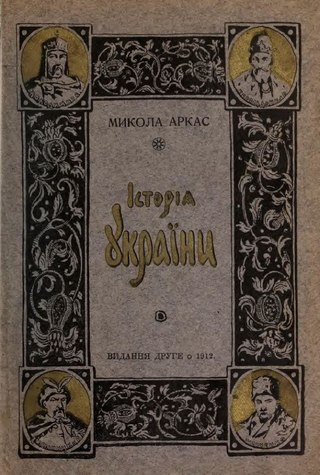
The Correspondence between the Ottoman sultan and the Cossacks, also variously known as the Correspondence between the Cossacks and the Ottoman/Turkish sultan, is a collection of apocryphal letters claiming to be between a sultan of the Ottoman Empire and a group of Cossacks, originally associated with the city of Chyhyryn, Ukraine, but later with Zaporizhzhia, Ukraine.

The Kharkiv Art Museum is one of the largest collections of fine and applied arts in Ukraine, a state museum.





